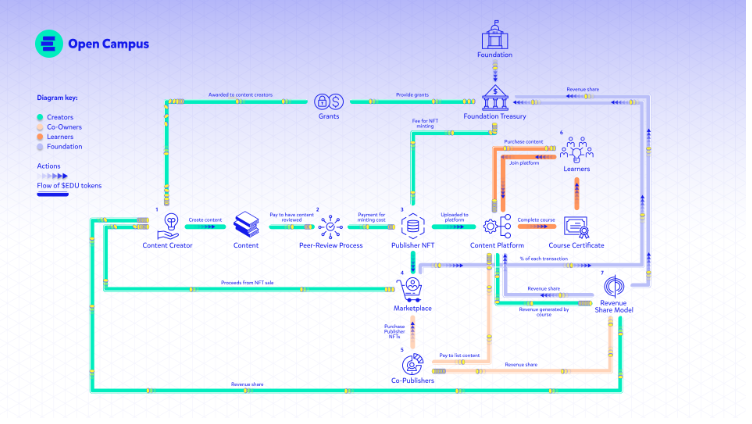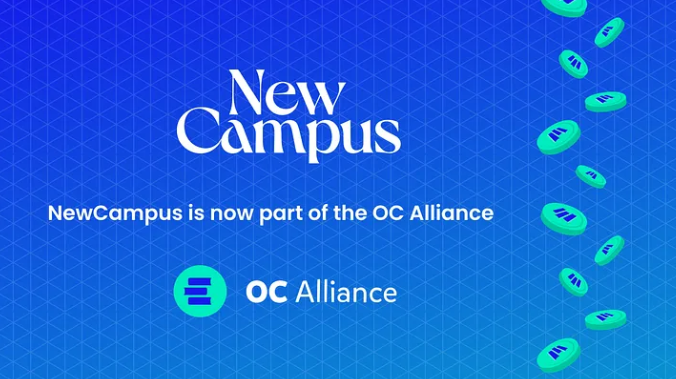Open Campus is a platform built with the goal of bringing decentralization, transparency and fairness in the education sector. An interesting point of Open Campus is its unique tokenomics designs with a focus on EDU tokens. In this article, let’s join Weakhand to learn about interesting points in the Open Campus economy.
What is Open Campus?
Open Campus is a platform built with the goal of bringing decentralization, transparency and fairness in the education sector. With Open Campus, everyone has the right to build, develop and promote their content globally and vice versa, based on the quality information sources they create, they can generate revenue from it.
The education market is an extremely lucrative market besides TradFi, but in the crypto market, there is almost no successful project. Open Campus is one of the flagships with the goal of bringing blockchain technology to the education industry and creating a new trend for the crypto market.
Operating Model of Open Campus
Before diving into Open Campus’s operating model, let’s take a look at the main participants in Open Campus’s economy including:
- Content Creators: Are content creators on Open Campus. These can be individual individuals or a creator collective (collection of content creators) producing high-quality videos and educational materials.
- Co – Publishers: These are co-publishers of educational content whose task is to promote educational content to more parents and students to receive a revenue share from Creators.
- Learners: These are students participating in studies on Open Campus, they will have access to leading teachers and content creators from many different countries.
- Foundation: This is an organization established by Open Campus that aims to connect components in the Open Campus ecosystem by leveraging the education and web3 expertise of partners with long-term experience in the market. .

Operating model of Open Campus
The following is the operating model on Open Campus implemented according to the following steps:
- Step 1: Content creators create educational content on Open Campus.
- Step 2: Content creators will have to pay an amount of EDU tokens to have their content reviewed before posting to Open Campus.
- Step 3: Peer reviewers conduct content approval from content creators. Once the content is approved, the content creator can pay an additional amount paid in EDU tokens so that their content can be tokenized as Publisher NFT.
- Step 4: Content creators can sell these Pulisher NFTs on the NFT Marketplace to receive some money. However, they will be deducted a small amount from the NFT sale profits and this amount will be transferred to the Open Campus Treasury.
- Step 5: Any user can purchase these Publisher NFTs to become Co Publisher and will receive a revenue share from content creators.
- Step 6: Co Publishers are responsible for promoting content to many learners. The more learners they refer, the more revenue they will receive shared from content creators.
- Step 7: Learners can register for an account on Open Campus, purchase courses paid with EDU tokens, and receive a certificate in NFT after completing the course.
Open Campus Review
Open Campus Flywheel
Open Campus Flywheel will take place as follows:
Open Campus attracts more and more Learners to learn on the platform → The amount of money earned from Learners increases —> Content Creators and Co – Publishers receive more revenue —> Create more content, promote more —> Attract more Learners → ….
Looking at Open Campus’s Flywheel, we see that the economic model has become more sustainable than the games that once made a big splash with the Play To Earn movement such as: Axie Infinity,… Although it still carries a bit of weight. It’s a bit like Ponzi when the more people participate, the more profits will be created, creating a growing economy.
But why do I say Open Campus’s economic model has become much more sustainable than previous Play To Earn games because Open Campus has brought its application more into the real world and clearly defined it? about the role of each user component in its platform:
- Content Creator: Just focus on writing content.
- Co – Publishers: Just focus on promoting and introducing the course.
- Learner: Just focus on learning.
Another point I find quite unique about Open Campus is that they have introduced the traditional Affiliate Marketing model into their economy. However, to achieve such a perfect Flywheel, Open Campus needs to build an infrastructure including a number of users, original Content Creators and Co – Publishers. So what has Open Campus done, let’s find out.
Open Campus with initial steps

Open Campus launches OC Alliance
OC Alliance has its first members including: CoderSchool – an online learning platform for programming lovers in Vietnam, Atiom – A company with online courses to help improve soft skills, …
In addition, recently, Open Campus established a DAO that allows users to use EDU tokens to participate in votes for decisions on the platform. This aims to create a community-oriented decentralized platform and of course the EDU Token is an extremely important part of the platform.
summary
In general, Open Campus’s first step is to bring their model to many online learning platforms. This helps Open Campus gain a base of learners and content creators available across platforms. Of course, as Open Campus grows, the EDU token will benefit greatly. Above is all the information I want to provide in this article, hope everyone has received interesting knowledge.


